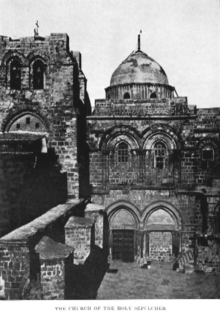Immovable Ladder

The Immovable Ladder (Hebrew: סולם הסטטוס קוו, lit. "The status quo ladder") (Arabic: السُّلَّم الثَّابِت, lit. "The stationary ladder") is a wooden ladder located above the entrance, under the window of the Church of the Holy Sepulchre in the Old City of Jerusalem. Made of cedar wood, possibly from Lebanon, it was first mentioned in 1757 and has remained in that location since the 18th century, aside from being temporarily moved on two occasions. The ladder is referred to as "immovable" due to an understanding that no cleric of the six ecumenical Christian orders may move, rearrange, or alter any property without the consent of the other five orders.[1]
Upon the Pontifical orders of Pope Paul VI in 1964, the ladder was to remain in place until such a time as the Catholic Church and the Orthodox Church reach a state of ecumenism. The ladder has since been related to the agreement of Status Quo that defined the six Christian religious orders that claim rights over the use of the Church of the Holy Sepulchre. The primary conflicts, however, surrounding the ladder and its immovability have been disputed by a lasting conflict between the Greek Orthodox Church and the Armenian Apostolic Church.
History

According to various accounts, the ladder once belonged to a mason who was doing restoration work in the Holy Sepulchre. The first account to mention the ladder was related to a firman (edict) dated in 1757 by Ottoman Sultan Abdul Hamid I followed by another edict by Sultan Abdülmecid I in 1852. The ladder is thought to be owned by the Armenian Apostolic Church along with its accompanying ledge.[2]

Various lithographs show that the ladder was in place by the late 1830s. Possibly the oldest image is an engraving that the Franciscan Custody of the Holy Land dates to 1728. While the Franciscans make no reference to the ladder, something in the form of a ladder can be seen in the right window above the entrance. The earliest photograph showing the ladder dates from the 1850s.[3]
In 1981, an attempt to remove the ladder from its location was made, but was quickly prevented by local Israeli police though the culprit was not caught. In 1997, the ladder was removed and remained missing for weeks. Thought to be a prank, it was returned later amidst rumor of further conflicts between the Armenian Apostolic Church and the Greek Orthodox Church leaders.[4] In 2009 the ladder was moved again. It was placed against the left window for a short period, perhaps in order to clear scaffoldings at the completion of renovating the bell tower.[5] Since the ladder's symbolism is so important, it is not allowed to decay completely, and new immovable ladders have been used over the years, since "if it goes rotten, it must be replaced."[6]
Ecumenical significance
Objectively, the ladder is not an absolute measure of ecumenism. Various key differences in rituals, liturgy, dogma and theology divide the two churches, rather than the dispute over ownership and use of the Church of the Holy Sepulchre. However, during his pilgrimage to the Holy Land in 1964, Pope Paul VI described the ladder as a visible symbol of Christian division,[7] and it is generally regarded as culturally significant as a visible symbol of the Status Quo agreement among the six ecumenical Christian orders.
In his book Jerusalem: The Biography, author Simon Sebag Montefiore says that "tour guides claim [the ladder] can never be moved without other sects seizing it. In fact, the ladder leads to a balcony where the Armenian superior used to drink coffee with his friends and tend his flower garden: it is there so that the balcony can be cleaned."[8]
Film
In the 2009 film Paolo VI, il Papa Tempesta (Paul VI, the Pope in the Tempest), the immovable ladder was briefly mentioned and discussed by Pope Paul VI to his private secretary, Archbishop Pasquale Macchi, citing that the ladder has been in place for 16 years prior to the year 1964. The description of the ladder being said to be placed there in 1948 is incorrect.
References
- ↑ The six Christian religious orders are the Latins (Roman Catholics), Greek Orthodox, Armenian, Syriac Orthodox, Coptic Christians and Ethiopians.
- ↑ Cust, L. G. A. (1929). The Status Quo in the Holy Places. H.M.S.O. for the High Commissioner of the Government of Palestine. p. 17.
Above the doorway runs a classical cornice, a relic of the Byzantine buildings. This is reached from the windows of the Armenian Chapel of St. John, and this Community has the use thereof on the occasion of the festival ceremonies that take place in the Courtyard. The upper cornice is used in the same manner by the Orthodox. These two cornices are in a damaged condition and the whole facade is badly weather-beaten and requires expert attention.
- ↑ Günther Simmermacher. The Holy Land Trek: A Pilgrim's Guide. Southern Cross Books, Cape Town. p. 194-5. ISBN 978-0-9921817-0-3.
- ↑ Lancaster, James E. "The Church and the Ladder: Frozen in Time". Retrieved 31 December 2016.
- ↑ Who Moved thy Ladder?
- ↑ Jacobs, Daniel (2009). The Rough Guide To Jerusalem. Rough Guides. ISBN 978-1848361935.
- ↑ Günther Simmermacher. The Holy Land Trek: A Pilgrim's Guide. Southern Cross Books, Cape Town. p. 196. ISBN 978-0-9921817-0-3.
- ↑ Simon Sebag Montefiore (8 November 2011). Jerusalem: The Biography. Weidenfeld & Nicolson. p. 519n. ISBN 978-0-297-86692-3. Retrieved 30 October 2012.
Coordinates: 31°46′41.64″N 35°13′45.73″E / 31.7782333°N 35.2293694°E